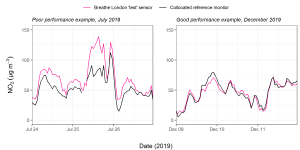Lower-cost air quality sensors can be a game changer for cities looking to understand and improve air quality at the neighborhood level. However, issues with accuracy have been a key barrier to their adoption. Our new paper shows how users can make the most of their data by evaluating sensor performance on a continuous basis.
Collocating sensors to track performance
As part of the Breathe London consortium, we installed 100 sensor devices across the city to measure key pollutants including nitrogen dioxide (NO2) and particulate matter for more than two years. Lower-cost sensors like the ones we installed are more sensitive than reference-grade instruments to environmental factors like temperature, relative humidity, or even levels of other pollutants. That can make their measurements less reliable in some environments, or even in certain seasons of the year.
To make sure our data was both accurate and useful, the Breathe London consortium developed rigorous quality assurance procedures. For our NO2 dataset, the procedures included multiple methods to calibrate the sensors, as well as applying an algorithm to correct for sensitivity to ozone, which the sensor can mistake for NO2.
While most of our sensors were collecting measurements at new locations across Greater London, we also installed two “test” sensors alongside London reference-grade monitors for most of the project. By tracking when data from these “test” sensors deviated from the more expensive reference instruments, we had an indication of how sensors across our network were performing at different times.

This approach provided a reality check for our pollution data. If the sensor network reported high NO2 values but the “test” sensors were completely off track from the reference at that time, we could infer that the network result may have been affected by poor sensor performance and adjust accordingly. This kind of ongoing sensor evaluation is important. Without it, users could mistake erroneous sensor data as evidence of major pollution events or local hotspots.
Why performance matters
Our NO2 sensors performed well most of the time, producing data that revealed a variety of actionable insights, including:
- Times of day and days of week with the highest pollution levels
- Regional pollution episodes (for example, a multi-day period with high pollution caused by weather conditions)
- Hotspot detection
- Impacts of sources on pollution patterns at different locations
- Long-term trends (for example, seasonal changes or year-over-year improvements)
Improving our understanding of air pollution in cities around the world
While the uncertainties associated with lower-cost sensors may make them unsuitable for some applications, our project demonstrates a way to generate actionable insights from sensors. The Breathe London network’s NO2 data shows that with rigorous quality assurance and ongoing evaluation of sensor performance, cities can utilize lower-cost sensors to better understand local air pollution. That can allow more communities to take advantage of this relatively new technology, even if they do not have the resources to purchase a network of more costly reference-grade monitors.
